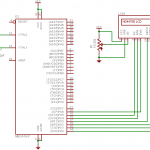HD44780 is a widely-used character-based LCD module that has been in production for several decades. These LCD modules are popular in a variety of electronic devices, such as clocks, measuring instruments, and microcontroller-based systems. They are relatively easy to use and provide a low-cost way to display information in real time. The HD44780 module supports up to 80 characters, which are arranged in two lines of 16 or 20 characters each.
Today, you will learn and gain knowledge, from the very beginning part of the HD4780-based displays to its software part.
Ok, let’s get the learning party started…
The HD44780 LCDs with AVR Microcontroller
You can simply apply the HD44780-based LCDs to be operated, either in 4-bit or 8-bit mode. If you select the 4-bit mode, the two nibbles of each byte are sent in a sequence on the high 4 bits of the data bus, such as in this order: DB7…DB4 and the low bits, DB3-DB0, are not connected.
Besides that, there are also the RS (Register Select) lines, which determine if the information should be interpreted as data or a command. The R/W (Read/Write) line plays a vital role to switch the data directly between the module and the microcontroller.
Software Part
If you are a layback person, you should find some existing code and then write it on your own. Well, the different libraries exist for use with assembler or C. You can try the lcd16 code by Ron Kreymborg, as it’s straightforward and only made for 2×16 character displays, which immensely suitable for the new beginners.
The above figure is the schematic diagram for this project; you can refer it, and it should help your project become easier. Few essential sources that may help to master LCD:
- Peter Ouwehand’s How to control an HD44780-based Character-LCD.
- LCD Module FAQ by Christopher Burian.
- Ron Kreymborg’s lcd16 library for AVRs with avrgcc.
- Procyon AVRlib. Library of many C-functions for AVR controllers, including a more comprehensive HD44780-library.
- AVR-Tutorial – 4. LCD. Describes how to use an HD44780 with an AVR microcontroller programmed in assembler (in German).
- Using An LCD In 4 bit Mode. Another introduction to HD44780s and AVR in assembler.
- Scott Bruck’s LCD FAQ Describes the physics and principles of operation of LCDs.
HD44780 displays are still used today, despite being an older technology. There are a few reasons for this:
- Low Cost: HD44780 displays are relatively inexpensive, making them a popular choice for low-cost electronics projects.
- Wide Availability: HD44780 displays have been around for several decades, which means they are widely available and supported by a wide range of microcontrollers and other devices.
- Ease of Use: HD44780 displays are relatively easy to use and do not require much programming knowledge or special drivers to get started.
- Simple Interface: The HD44780 display has a simple interface with just a few pins required to communicate with the microcontroller, making it an easy choice for beginner electronics enthusiasts.
- Robustness: HD44780 displays are known for their robustness and durability, which makes them a popular choice in applications where the display may be exposed to harsh environments or subjected to frequent use.
While newer display technologies may offer higher resolution or more advanced features, HD44780 displays remain a popular choice for a wide range of applications due to their low cost, ease of use, and wide availability.




HI,
this direction is realy useful for me.
we are using lcd16 at our microcontroller laboratory. i’m an irainian unversity student.
Thanks a lot
You might be interested in linking to my tutorial, which is really in depth: http://www.robotenthusiasts.com/page/index.html/_/tutorials/pic-microcontrollers/hd44780-lcd-r14